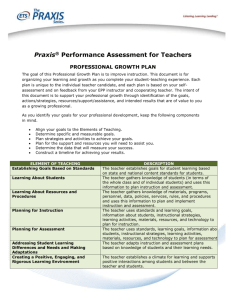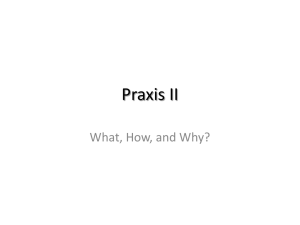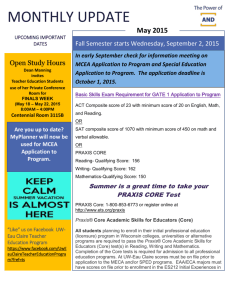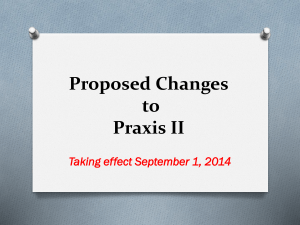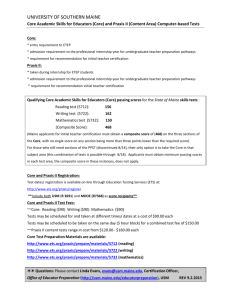Praxis II Workshop - Westminster College
advertisement
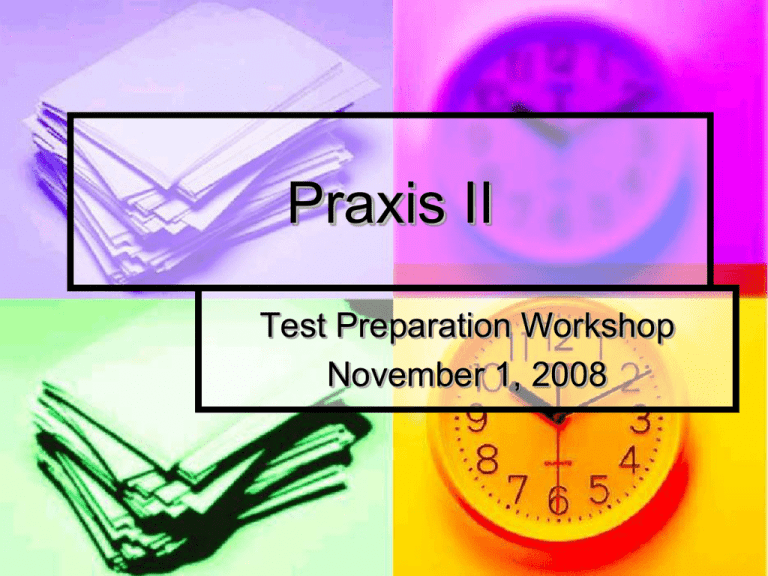
Praxis II Test Preparation Workshop November 1, 2008 Why Praxis? No Child Left Behind Act of 2001 Requires all teachers in public schools to be “Highly Qualified” Three requirements: Bachelor’s degree Full state teacher certification Subject matter competency Subject Matter Competency Individual states choose how to test subject matter competency Utah uses the Praxis II test developed by Educational Testing Service (ETS) Utah State Law Requires educators to take the Praxis II exam in any subject they wish to teach Here’s the good news…! Any educator who scores below the final Utah state score will be issued a non-renewable conditional Level 1 license. If the educator fails to pass the Praxis during the three-year duration of the conditional license, the license will lapse School of Education Requirement Must register for Praxis II exam before student teaching Which Praxis? Praxis II not Praxis I Content only – no pedagogical requirements Must take Praxis II for any subject area in which you plan to teach! How Do I Register for the Praxis II? http://www.ets.org website http://www.ets.org>Praxis>state requirements>Utah Be sure to include Westminster College and Utah State Office of Education They assess content knowledge you have learned in order to teach it to others. They are comprehensive—covering materials you may have learned in several courses during more than one year. Content questions may be embedded in pedagogical situations. Content knowledge Praxis exams are all multiple choice Very few simple identification questions of the sort “Which of the following authors wrote Moby Dick?” Rationale—prospective teachers should be able to analyze, synthesize, and apply knowledge to specific examples. So . . . It might take longer to respond and questions may take longer to read. Learn What The Test Covers—See specifications in the Tests at a Glance at www.ets.org/praxis. Assess How Well You Know The Content. Collect The Materials You Need to Study. Plan And Organize Your Time. Study. [See TAAG for detailed test descriptions, sample questions with answers and explanations, tips on pacing, guessing] Know the Multiple-Choice Question Types “Which of the following . . . “ “Complete the statement . . . “ “Roman Numeral Choices” “Least, Except, Not” “Graphs, Tables, Reading Passages” Other Formats This format limits your choice of answers only to the list given. Example: “Which of the following” is a flavor made from beans? a) Strawberry b) Cherry c) Vanilla d) Mint You are given an incomplete statement. You must select the choice that will make the completed statement correct. Example “The underlying concepts of division most likely will be understood by the greatest number of children if the teacher a) presents the concept of division in several ways b) thoroughly explains the theory of division c) provides one easy step-by-step procedure for dividing d) stresses the everyday usefulness of understanding division This format is used when there can be more than one correct answer from the list. Example The term “gender gap” is used in a political science context to refer to differences in survey response data from women and men in which of the following areas? I. II. III. The relative importance of domestic versus foreign-policy issues Attitudes regarding such social issues as gun control or pornography Specific foreign-policy issues such as military issues a) b) c) d) I only II only I and III only I, II, and III This type of question is used in situations in which there are several good solutions, or ways to approach something, but also a clearly wrong way to do something. You must be very careful! It’s easy to forget that you are selecting the negative! These words will be in ALL CAPS!! Example The Fair Labor Standards Act of 1938 did all of the following EXCEPT a) Establish a minimum wage of 40 cents an hour b) Require the hiring of women and members of minority groups for some government jobs c) Fix the workweek at 40 hours d) Forbid the hiring of workers under the age of sixteen The important thing to keep in mind is to answer the question that is asked . . . So, you might want to read the question first and then look at the graph or chart or reading passage. You may not need to spend a great deal of time trying to understand a graph or passage fully when you are asked a very specific question about it. Example How many of the countries shown in the graph produced more crude oil in 1975 than in 1974? a) None 6 b) One 5 c) Two 4 d) Three 3 1974 2 1975 1976 1 0 Soviet Union United States Saudi Arabia Iran New formats are developed from time to time. As always, read the directions carefully. Then ask yourself what you are supposed to be looking for, and what details are given in the question that help you find the answer. Example The following question asks you to analyze teacher goals and actions intended to lead to the achievement of the goal. Decide whether the action makes it likely or unlikely to lead to the achievement of the goal. GOAL: To increase the participation of low-achieving middle-school students in whole-class discussions. ACTION: Instead of asking for volunteers, the teacher randomly calls on students to discuss homework assignments. a) Likely, because students who feel anxiety about being called on will be more at ease and will pay more attention to class discussion. b) Likely, because low-achieving students often hesitate to volunteer and random questioning will increase responses from these students. c) Unlikely, because students in the middle-school grades prefer to have a choice in responding to discussions. d) Unlikely, because students’ positive feelings toward the teacher will decrease. Okay . . . Let’s take a test! Special Guests: › Charity Gleason: Secondary › John Cedarland: Elementary Formulating a Study Plan Learn what the test covers Assess how well you know the content Collect materials to help you study material from the subjects/grades you’ll be teaching Core curriculum, see http://www.uen.org Tests at a Glance (TAAG) ETS Study Guides Cliffs Notes Test Prep Guides Formulating a Study Plan Plan and organize your time Be familiar with question types Study Take advantage of practice tests and study tips available from ETS. RELAX! GOOD LUCK!! CELEBRATE!!!
